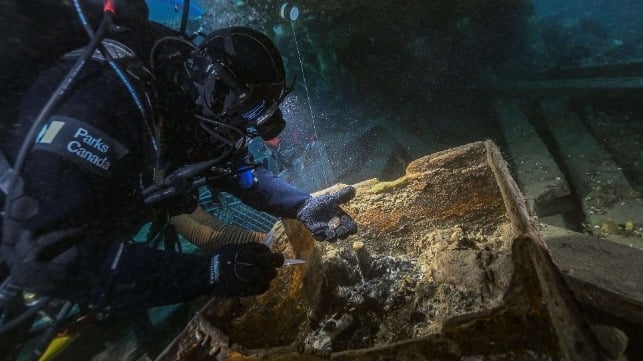Archaeologists Find New Artifacts Aboard Franklin's HMS Erebus

Parks Canada is breaking new ground in efforts to unravel the mysteries of the Franklin Expedition of 1845, collecting artifacts and thousands of high-quality images from the wrecks of HMS Erebus and HMS Terror.
Archaeologists returned to the Nunavut site over the summer for another season of research on the wrecks, with most of the work carried out on Erebus. Over the course of 12 days, the team aboard the research vessel David Thompson conducted 68 dives to continue investigating and documenting the wreck.
In an officer's cabin, the divers found artifacts related to navigation, science and leisure. These are believed to belong to Second Lieutenant Henry Dundas Le Vesconte. The items included a parallel rule, an intact thermometer, a leather book cover and a fishing rod with a brass reel.
Other items such as a leather shoe or boot bottom, storage jars and a sealed pharmaceutical bottle were found in an area believed to br the Captain’s Steward’s pantry. They also excavated a seamen’s chest in the forecastle area, where most of the crew lived, which held pistols, footwear, medicinal bottles and coins.
 Archaeologist Marc-André Bernier excavates a seamen’s chest in the forecastle of HMS Erebus (Parks Canada)
Archaeologist Marc-André Bernier excavates a seamen’s chest in the forecastle of HMS Erebus (Parks Canada)
The 1845 expedition led by Sir John Franklin on a quest to find the Northwest Passage, a sea route between the Atlantic and Pacific oceans, remains one of the most mysterious tragedies of the era. Both ships were lost and all 129 men on board perished. The tragedy is considered the worst disaster in the history of British polar exploration.
The vessels were discovered in 2014 and 2016, thanks in part to Inuit traditional knowledge of their location. The government of the United Kingdom gifted the wrecks to Canada in 2018, and they are monitored and administered jointly by the Inuit and Parks Canada.
In the latest attempt to resolve the mystery, the archaeologists began excavating a seamen’s chest in the forecastle area, where most of the crew lived, and which held numerous artifacts including pistols, military items, footwear, medicinal bottles and coins. The team also captured thousands of high-resolution digital photos, which will be used to make precise 3D models of the site's condition.
The recovered artifacts will be studied in Ottawa and undergo conservation treatment before being returned for display at the Nattilik Heritage Centre in Gjoa Haven (Uqsuqtuuq), Nunavut.
